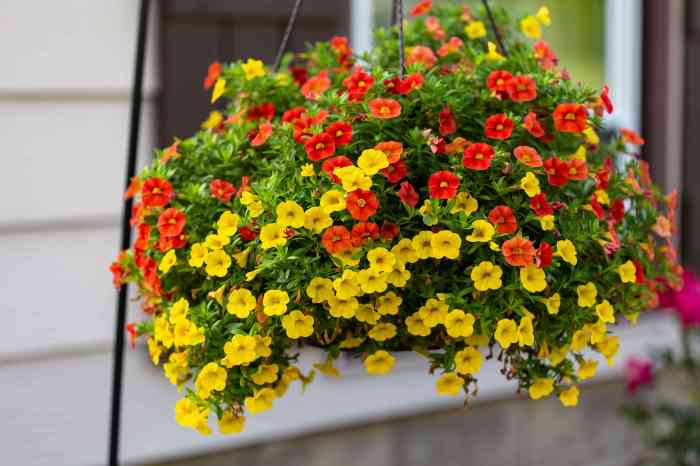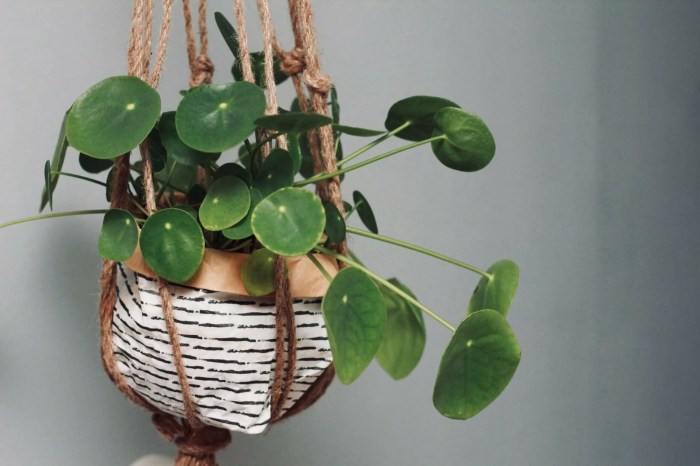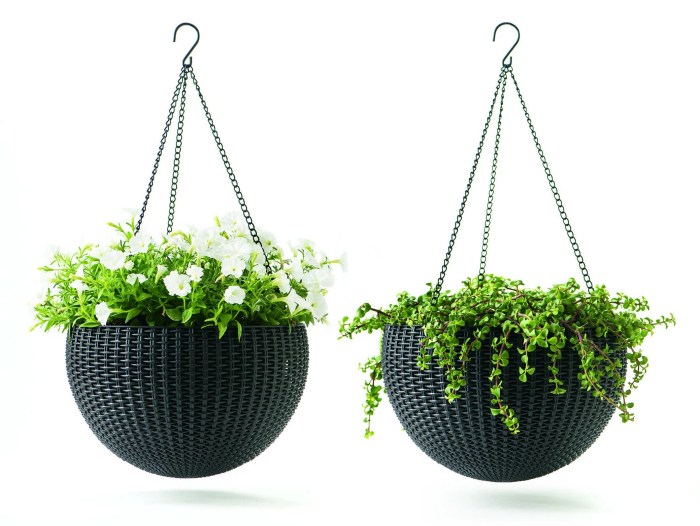Good plants for indoor hanging baskets can transform any room into a vibrant and inviting space. With their cascading foliage and eye-catching blooms, these plants add a touch of nature and style to any décor.
Whether you’re looking for lush greenery, vibrant colors, or fragrant blooms, there’s a perfect plant for your indoor hanging basket. From trailing ivy to cascading ferns, these plants are easy to care for and will bring years of enjoyment.
Suitable Plants for Indoor Hanging Baskets

Indoor hanging baskets offer a captivating way to bring greenery and natural beauty into your home. With a plethora of plant species to choose from, selecting the perfect plants for your indoor hanging baskets is crucial. This comprehensive guide presents an array of suitable plants, each offering unique characteristics and benefits, ensuring you can create a stunning indoor oasis.
Good plants for indoor hanging baskets can bring a touch of nature and color to any room. Flowering trailing plants are a great choice for hanging baskets, as they will cascade over the sides of the basket and create a beautiful display.
Some popular flowering trailing plants include petunias, impatiens, and begonias. These plants are relatively easy to care for and will thrive in bright, indirect light.
When selecting plants for indoor hanging baskets, consider factors such as the amount of sunlight your space receives, the size and shape of the basket, and your personal preferences for foliage and color. The following plant species are highly recommended for their adaptability, aesthetic appeal, and ease of care in indoor hanging baskets:
Spider Plants
- Spider plants ( Chlorophytum comosum) are renowned for their cascading foliage and easygoing nature. Their long, arching leaves, often variegated with white or cream stripes, add a touch of elegance to any space.
- Spider plants are highly tolerant of neglect and can thrive in a wide range of light conditions, making them ideal for both bright and low-light environments.
- They are also known for their air-purifying qualities, helping to remove toxins from the air and improve indoor air quality.
Pothos
- Pothos ( Epipremnum aureum) is another popular choice for indoor hanging baskets due to its trailing vines and variegated foliage.
- Its heart-shaped leaves come in a variety of colors, including green, yellow, and white, adding a vibrant touch to any room.
- Pothos is highly adaptable and can tolerate low light conditions, making it a great option for dimly lit spaces.
Ferns
- Ferns bring a touch of the outdoors into your home with their lush, feathery fronds.
- They prefer indirect light and moist soil, making them ideal for humid environments such as bathrooms or kitchens.
- Some popular fern species for hanging baskets include Boston ferns ( Nephrolepis exaltata), maidenhair ferns ( Adiantum capillus-veneris), and staghorn ferns ( Platycerium bifurcatum).
Succulents
- Succulents are a great option for those who prefer low-maintenance plants.
- These drought-tolerant plants come in a variety of shapes and sizes, adding a unique touch to your hanging baskets.
- Some popular succulent species for hanging baskets include string of pearls ( Senecio rowleyanus), burro’s tail ( Sedum morganianum), and echeverias.
Trailing Begonias
- Trailing begonias ( Begonia semperflorens) add a splash of color to your indoor hanging baskets with their vibrant blooms.
- These plants prefer bright, indirect light and well-draining soil.
- They come in a wide range of colors, including pink, red, white, and yellow.
Air Plants
- Air plants ( Tillandsiaspp.) are a unique choice for indoor hanging baskets as they do not require soil to grow.
- These epiphytes absorb nutrients and moisture from the air, making them easy to care for.
- They come in a variety of shapes and sizes, adding a touch of whimsy to your hanging baskets.
Hanging Basket Design and Aesthetics

Hanging baskets add a touch of greenery and visual appeal to any indoor space. When selecting a hanging basket, consider the plant selection and desired aesthetic to choose the appropriate design and style. From classic woven designs to modern geometric shapes, hanging baskets come in various materials, including wicker, metal, plastic, and macrame.
Material Considerations
- Wicker:Natural and rustic, suitable for traditional or cottage-style décor.
- Metal:Durable and available in a range of finishes, from copper to black.
- Plastic:Lightweight and weather-resistant, ideal for outdoor or humid environments.
- Macrame:Bohemian and artistic, adds texture and interest to any space.
Shape and Size
The shape and size of the hanging basket should complement the plant selection. Round baskets suit cascading plants like ferns, while rectangular baskets accommodate trailing plants like ivy. The size of the basket should be proportionate to the plant’s growth habit and root system.
Creating Visually Appealing Arrangements
Combining different plants and colors in a hanging basket creates a visually striking display. Consider the following tips:
- Height Variation:Use plants of varying heights to add depth and interest.
- Color Harmony:Choose plants with complementary or contrasting colors to create a cohesive look.
- Texture Contrast:Combine plants with different textures, such as smooth leaves and frilly fronds.
- Focal Point:Select a standout plant as the focal point of the arrangement, surrounded by supporting plants.
Care and Maintenance of Indoor Hanging Baskets

Indoor hanging baskets offer a charming and space-saving way to add greenery to your home. However, proper care and maintenance are crucial to ensure their health and longevity.
Optimal Lighting Conditions
Indoor hanging baskets thrive in bright, indirect light. Place them near a window that receives plenty of natural light but avoid direct sunlight, which can scorch leaves. If natural light is insufficient, consider using artificial light sources such as grow lights or fluorescent bulbs.
Watering Techniques
Water your hanging baskets regularly, allowing the soil to dry out slightly between waterings. Avoid overwatering, as soggy soil can lead to root rot. The frequency of watering will depend on factors such as the plant type, pot size, and humidity levels.
Spider plants, ferns, and pothos are excellent choices for indoor hanging baskets, adding a touch of greenery and freshness to any space. Consider displaying these lush plants in stylish geometric indoor wall planters to elevate your home décor and create a captivating vertical garden.
These planters, with their sleek lines and modern designs, complement the beauty of indoor hanging plants, showcasing them as stunning focal points.
Pruning and Fertilizing
Regular pruning is essential to maintain the shape and health of your hanging baskets. Remove dead or damaged leaves and stems, and trim back overgrown plants to encourage bushier growth. Fertilize your plants monthly during the growing season using a balanced liquid fertilizer.
Troubleshooting Common Issues

Maintaining the health and longevity of indoor hanging baskets requires addressing common issues that may arise. These issues can range from pests and diseases to nutrient deficiencies. By understanding the signs and symptoms of these problems and implementing effective solutions, you can ensure the well-being of your hanging plants.
For indoor hanging baskets, there are a wide variety of plants that can thrive in these suspended environments. Some popular choices include ferns, ivy, and pothos. These plants are known for their ability to tolerate low light conditions and can add a touch of greenery to any room.
For a more unique and stylish option, consider using an ecosides wall planter . These planters are made from recycled materials and are designed to create a living wall of plants. With the right plants, indoor hanging baskets can bring life and color to any space.
Preventive measures play a crucial role in minimizing the risk of problems. Proper watering, adequate lighting, and regular fertilization are essential for maintaining plant health. Additionally, ensuring good air circulation and avoiding overcrowding can help prevent the spread of pests and diseases.
Pests
Common pests that affect indoor hanging baskets include aphids, mealybugs, and spider mites. These pests can cause damage to leaves, stems, and flowers, leading to stunted growth and reduced plant health.
- Aphids:Aphids are small, soft-bodied insects that feed on plant sap. They can be green, black, or brown in color and are often found on the undersides of leaves or at the tips of stems.
- Mealybugs:Mealybugs are small, white insects that produce a waxy substance on their bodies. They can be found on stems, leaves, and in leaf axils.
- Spider mites:Spider mites are tiny, spider-like creatures that feed on plant sap. They produce fine webs on the undersides of leaves.
Diseases
Fungal and bacterial diseases can also affect indoor hanging baskets. These diseases can cause a variety of symptoms, including leaf spots, wilting, and stunted growth.
- Botrytis blight:Botrytis blight is a fungal disease that causes gray or brown spots on leaves and flowers. It is most common in humid environments.
- Powdery mildew:Powdery mildew is a fungal disease that causes a white or gray powdery substance on leaves.
- Bacterial leaf spot:Bacterial leaf spot is a bacterial disease that causes brown or black spots on leaves.
Nutrient Deficiencies
Nutrient deficiencies can occur when plants do not receive adequate amounts of essential nutrients from the soil or fertilizer. These deficiencies can lead to a variety of symptoms, including yellowing of leaves, stunted growth, and reduced flowering.
- Nitrogen deficiency:Nitrogen deficiency causes leaves to turn yellow or pale green. Plants may also experience stunted growth.
- Phosphorus deficiency:Phosphorus deficiency causes leaves to turn purple or reddish. Plants may also experience stunted growth and reduced flowering.
- Potassium deficiency:Potassium deficiency causes leaves to turn yellow or brown around the edges. Plants may also experience stunted growth and reduced flowering.
Additional Tips and Considerations: Good Plants For Indoor Hanging Baskets

Incorporating indoor hanging baskets into room designs can enhance aesthetics and optimize space. When selecting plants, consider complementing existing decor to create a cohesive ambiance.
Creative Ideas for Room Integration, Good plants for indoor hanging baskets
- In living rooms, suspend baskets from the ceiling to create a focal point and add greenery.
- In kitchens, hang baskets above kitchen islands or sinks for easy access to herbs or trailing plants.
- In bedrooms, place baskets on bedside tables or hang them from the ceiling to create a calming atmosphere.
Space Optimization and Vertical Interest
Hanging baskets maximize vertical space, allowing for more plants in limited areas. They create a sense of height and depth, adding dimension to rooms.
Plant Selection for Cohesive Decor
- For modern interiors, opt for sleek and structured plants like snake plants or ZZ plants.
- For bohemian or eclectic styles, choose trailing plants like pothos or spider plants.
- For traditional decor, select flowering plants like orchids or begonias.
Final Review

With the right plants and a little care, you can create a beautiful and thriving indoor oasis with hanging baskets. These versatile plants are a great way to add life and color to any room, and they’re sure to impress your guests.
Common Queries
What are the best plants for indoor hanging baskets?
Some of the best plants for indoor hanging baskets include pothos, spider plants, ferns, and ivy. These plants are easy to care for and can tolerate a variety of light conditions.
How often should I water my indoor hanging baskets?
Water your indoor hanging baskets when the soil feels dry to the touch. Avoid overwatering, as this can lead to root rot.
How can I keep my indoor hanging baskets looking their best?
To keep your indoor hanging baskets looking their best, fertilize them regularly and prune them as needed. You should also rotate them occasionally to ensure that all sides of the plants receive sunlight.